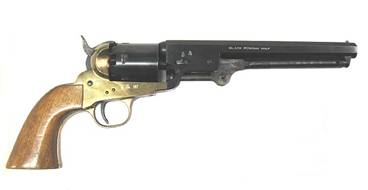 |
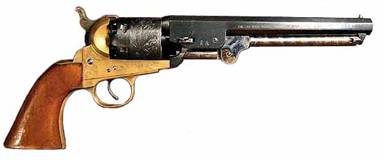 |
|
Fig.
1 Schneider &
Grassick with Plain, Un-engraved Cylinder
|
Fig.
2 Model 1851 Navy
Brass with engraved Cylinder
|
One of the ways that the manufacturers were able to reproduce the
different replica revolvers was to acquire an original to copy in
detail. Most importers who
were anxious to enter this market did not know that much about the
originals themselves so would simply “borrow” an original revolver,
send it to the manufacturer, and that is the revolver that was copied.
This was done for nearly every model replica that has been
manufactured. The
manufacturers would cut corners in the manufacturing process in order to
simplify procedures or deliberately to be able to distinguish the
replica from an original. These
manufacturers subcontracted other shops for various parts and sometimes
for completed revolvers. They
were no different than automobile manufacturers who subcontract to
various other manufacturers for the various parts on their automobiles.
As a result we find many replicas being marketed as something
that it isn’t.
We
have to remember that the whole replica industry was targeted for the
shooters, not collectors. As
this market became more and more competitive, manufacturers would
produce whatever any importer wanted.
In the early 1960’s the Colt 1851 Navy type revolver was the
most popular and more parts were available from most small shops in the
Brescia Provence area of Italy. The
same frame could be used for more than one different model of a
revolver. Navy Arms used the
same frame for the 1851 Navy, 1851 Navy Sheriff,
Leech & Rigdon, and Leech & Rigdon Sheriff.
Their Griswold & Gunnison “Reb” (Fig. 3) had the same frame but in
brass, a Dragoon style barrel, and an un-engraved cylinder.
If an octagon barrel is used rather than a Dragoon style barrel a
Griswold & Gunnison replica becomes Schneider & Glassick (Fig.
4) replica.
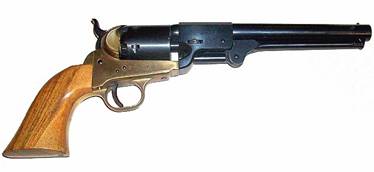 |
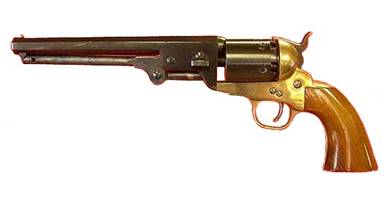 |
|
Fig.
3 Griswold &
Gunnison with Plain Cylinder & Dragoon Type Barrel
|
Fig.
4 Schneider &
Glassick with Plain Cylinder & Octagon Barrel
|
Even though these revolvers were extremely cheap by today’s standards,
shooters were looking for even cheaper “deals”.
EIG Cutlery was the first importer of a historically accurate
Schneider & Glassick replica. It
was sold as an “1851 Navy with a brass frame”. Saul
Eig was the founder of this company, thus EIG as an importer name.
EIG Cutlery imported goods from several different countries and
is best known for the knives they had produced.
The EIG revolvers bear a manufacturer’s logo that I have not
been able to identify. They
also imported a nice, fully engraved model as well.
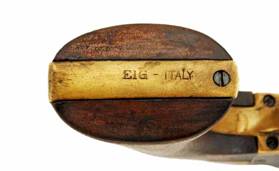 |
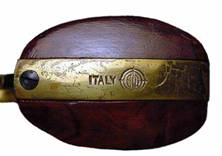 |
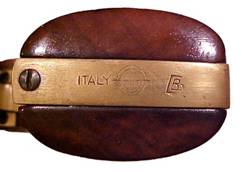 |
|
Fig.
5 Early EIG Marking
|
Fig.
6 EIG Logo
|
Fig.
7 EIG Logo with
GLB
Manufacturer
Logo
|
The earliest date of manufacture is around 1963.
RPRCA has two Schneider & Glassick replicas with this date
code. One is fully engraved
and the other is plain. EIG
became involved in a law suit and they closed up shop, selling all
replica revolver inventories to FIE, also of
Florida
. Thus this “GB”
manufacturer’s logo may also be found on some of their revolvers.
RPRCA has one such FIE specimen.
This occurred in the early 1970’s.
These are rare.
So, if the importers did not specifically order Schneider & Glassick
replicas why do these revolvers exist.
Very simply, the plain cylinder saved a step in manufacturing and
saved a buck in cost. The Schneider &
Glassick replicas accidentally came into existence.
The un-engraved, plain cylinders used on the Griswold &
Gunnison replicas were also combined with an octagon barrel and we have
a Schneider & Glassick replica.
All other brass frame 1851 Navy type revolvers with the engraved
Colt’s Ormsby Naval Engagement Scene are just that, 1851 Navy models
with a brass frame. Other
inaccurate variations of the Schneider & Glassick replicas are those
in .44cal. both with plain and engraved rebated cylinders.
Again, this was to meet the desires of the main market, the
shooters. For my purposes I
use the nomenclatures of Model 1851 Navy Brass for .36cal. and Model
1851 Army Brass for .44cal. The
Model 1851 Army Brass has a rebated Cylinder.
Lists of Manufacturers/Distributors who have imported and marked their
revolvers thus far observed are listed in Table 1.
Table
1
|
Importer
|
Manufacturer
|
Year
|
| Fig.
8 Eig |
“
GLB
” Unknown |
1963 |
| Fig.
9 Hawes |
Armi
San Paolo |
1969 |
| Fig.
10 Hawes
Sheriff |
Armi
San Paolo |
1969 |
| Fig.
11 FIE
Inventory from EIG |
“GB”
Unknown |
1970 |
| Fig.
12 Liberty Arms |
Pietta |
1970 |
| Fig.
13 Centennial
Arms Sheriff |
Investarms |
1971 |
| Fig.
14 Centennial
Arms |
Unknown |
1971 |
| Fig.
15 Hy
Score |
Euroarms
Brescia ASP |
1972 |
| Fig.
16 Jana |
Euroarms
Brescia ASP |
1972 |
| Fig.
17 Investarms |
Investarms |
1973 |
| Fig.
18 High
Standard |
High
Standard using Imported parts from Italy
|
1974-76 |
| Fig.
19 Euroarms
of
America
|
Armi
San Paolo |
1976
|
| Fig.
20 Richland
Arms |
Pietta |
1977 |
| Fig.
22 Palmetto |
Palmetto |
2000 |
| Fig.
23 Pietta |
Pietta |
Current |
Markings
on Schneider & Glassick Revolvers
|
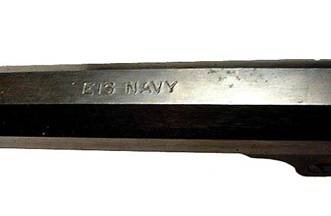 |
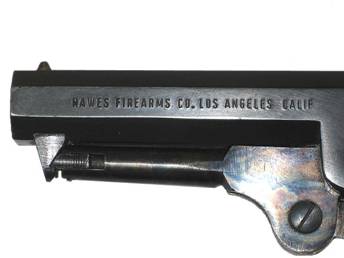 |
|
Fig.
8 EIG Barrel
Marking |
Fig.
9 Hawes
Sheriff Model Barrel Marking |
|
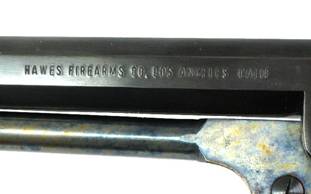 |
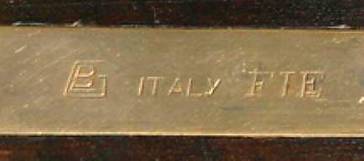 |
|
Fig.
10 Hawes
Barrel Marking
|
Fig.
11 FIE
Barrel Marking |
|
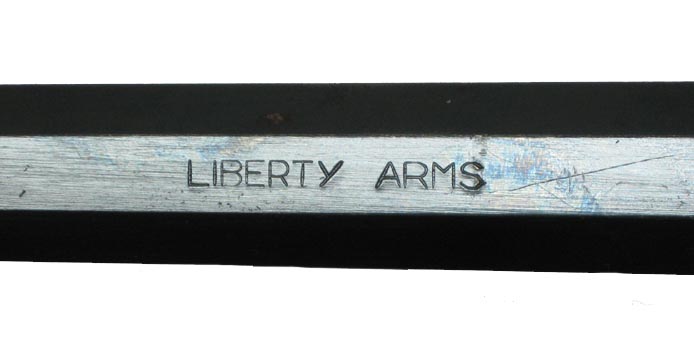
|
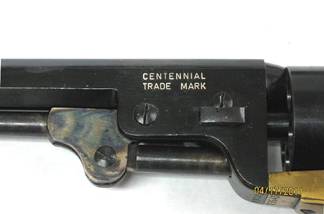 |
|
Fig.
12 Liberty Arms Barrel Marking |
Fig.
13
Centennial
Arms Sheriff Frame Marking |
|
 |
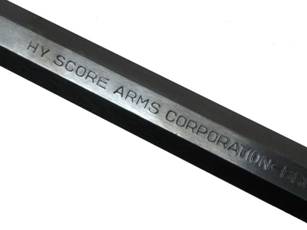 |
|
Fig.
14
Centennial
Arms Barrel Marking |
Fig.
15 Hy Score |
|

|
 |
|
Fig.
16
Jana |
Fig.
17
Investarms |
|
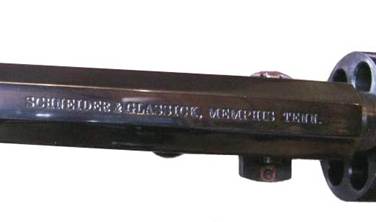
|
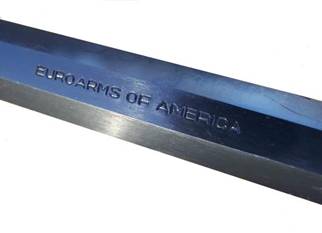 |
|
Fig.
18
High
Standard |
Fig.
19 Euroarms |
|
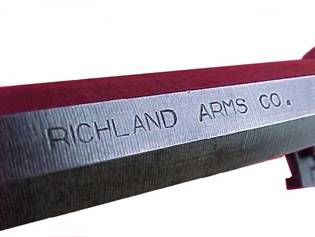
|
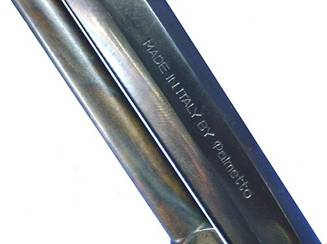 |
|
Fig.
20
Richland
Arms |
Fig.
21
Palmetto |
|
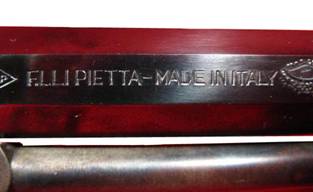 |
|
Fig.
22
Pietta |
Probably another reason that the Schneider & Glassick was not
targeted for replica production is its extreme rarity.
According to firearms historians and researchers there are only
three original revolvers that have been uncovered and one of these has a
steel frame rather than brass. Another
source claimed six revolvers being discovered but with some reservations
as to their originality. Other
researchers do not even count the Schneider & Glassick as a
legitimate Confederate manufactured revolver used in the Civil War.
I leave this to the historians since my interest is in the
replica production of this revolver.
However, the rarity of this revolver is the reason it was not
produced as a Schneider & Glassick specifically.
There was no “original” revolver available to copy.
It is the collectors that find an interest in these “accidental”
replica revolvers. These
were produced as a “cheap”, brass frame 1851 Navy for the shooters.
A few manufacturers did not engrave the cylinder simply to cut
cost. Most collectors and
shooters are familiar with the plain cylinder being correct on the
Griswold & Gunnison since this was the first Confederate revolver
reproduced by Gregorelli & Uberti for Navy Arms.
Since engraved cylinders were being produced for the 1851 Navy
many of these cylinders were put on the Griswold & Gunnison simply
to fill an order making it historically inaccurate.
This was also done using an octagon barrel making an inaccurate
Schneider & Glassick replica.
There
is one other manufacturer who produced a Schneider & Glassick
revolver. Rigarmi produced four revolvers that bear the barrel
markings:
-
ADDRESS BILL EDWARDS AFTON VA US AMERICA -
From
a letter I received from William Edwards dated August 24, 2002, he
states,
"In
the 1970s I obtained from Rino Galesi and from Luciano Amadi, Navys and
Remingtons. These were roll marked ADDRESS BILL EDWARDS
AFTON VA U S AMERICA in emulation of Colt's markings as I consider
that I was the spiritual in not the generic descendant of Sam
Colt"
There
were four replica revolvers supplied to Bill in an attempt to persuade
him to use Rigarmi as a future supplier of revolvers. Revolvers so
far uncovered was a Remington New Model Army, an 1960 Army, a Model 1851
Navy Brass with engraved cylinder, and a Schneider & Glassick.
Of course at that time the plain cylinder was an example of a cost
cutting step in production. All four of these revolvers are
currently in the RPRCA collection. All were obtained on auctions
on Gun Broker and Auction Arms. The three obtained on Auction Arms
were posted by Sarco, Inc. Bill had presented these three
revolvers to Charlie Steen, President of Sarco, Inc. four decades ago.
|
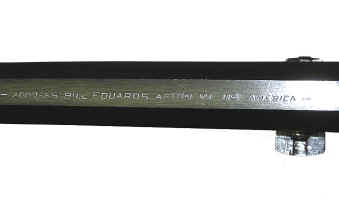
|
|
Fig. 23 Barrel Markings William Edwards Schneider &
Glassick |
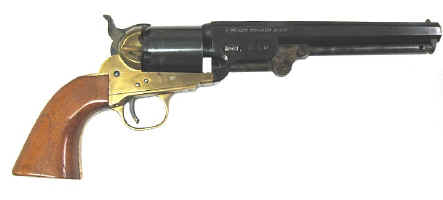 |
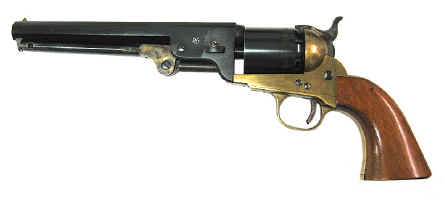 |
|
Fig. 24 Right Side William Edwards Schneider & Glassick |
Fig 25 Left Side William Edwards Schneider & Glassick |
|
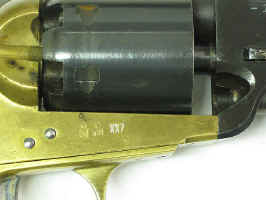
|
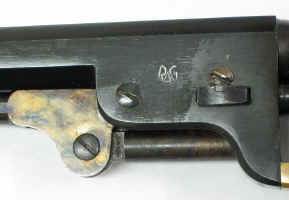
|
|
Fig. 26 Date Code on Left Side of Frame |
Fig. 27 Rigarmi Logo Left Side of Barrel Flat |
Fake Schneider & Glassick
Revolvers
The Schneider & Glassick replica is a target for counterfeiters for
several reasons. First,
original revolvers are so rare that there are few that can be studied
and compared in order to spot a fake revolver.
Counterfeiting original revolvers was one of the greatest fears
of collectors with the advent of the replica industry.
Colt collectors were the strongest in opposing the production of
replica revolvers. This
paranoia was so great on the part of a group of these collectors that
the National Rifle Association was bullied into refusing any advertising
for these revolvers. The
counterfeiting of Colt revolvers did not materialize because of the
abundance of research material and original guns that were available for
study and make comparisons. There
were very talented machinist and gunsmiths in the late 1940’s and
1950’s that were producing Paterson and large frame Colt fakes on a
one at a time basis, usual on special order by collectors who wanted to
fill a vacant spot in their collection.
A few of these were so good that they even fooled the Colt
experts.
This is not the case with the Italian made Colt replicas.
Deliberate changes have been made by manufacturers on their
replicas to specifically make them identifiable from an original.
One example of this is the absence of cylinder pins on the first
Gregorelli & Uberti Colt 1851 Navy replicas.
Other changes such as screw threads, grip shape, etc. was
incorporated into the replica revolvers in order to make them readily
identifiable from the originals.
The Confederate revolvers, however, are a different story.
First is the limited number of these revolvers that were
produced. Second is the
manufacturing methods used in the construction of these revolvers which
make them almost individually “one of a kind” firearms.
They were hand fitted and assembled so parts from one may not
work on another. This makes
it easy for a counterfeiter because there are no solid comparisons that
can be made between an original and an altered replica.
Third, many of the original revolvers did not even have a
manufacturer’s name stamped on the revolver.
If there was it may not always be in the same location, fonts may
differ, and serial numbers may not exist.
This makes the Schneider & Glassick an excellent choice for the
counterfeiter. With
supposedly only two of the brass frame versions in existence there is
little to compare with. A
knowledgeable replica collector may be a better judge in helping
identify a fake because they are more familiar with the different
manufacturers of the replicas, the markings on the gun, proof marks,
serial numbers, etc. In
examining a possible fake these marks would have to be removed.
This is going to leave dips in the metal, reduction in size of
certain parts, barrel twist, etc.
I recently won two revolvers on a Kull Old Town Station Auction that
were advertised as Fakes but that had previously passed for, and were
sold on another auction several years earlier as originals.
They were discovered to be counterfeit and were being
re-auctioned as such. One
that I won was a Schneider & Glassick, serial #2.
The font for the “Schneider & Glassick
Memphis Tenn” markings on the barrel was correct, the aging
appeared accurate, and overall appearance was good.
The give away was the location of the deep scratches and dips on
the frame and top of barrel. These
were in locations where other markings of the replica would have been.
They were removed and deep scratches were in these locations to
disguise where metal had been removed.
On the barrel there was small difference in size where the
Schneider & Glassick markings were stamped and the rest of the
barrel. There were other
indications as well.
|
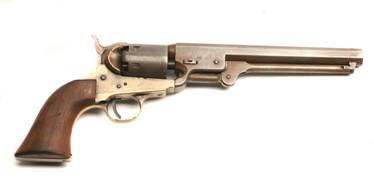 |
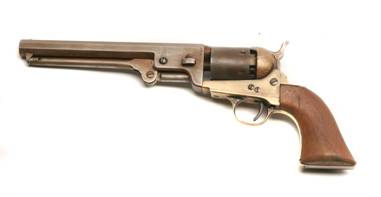 |
|
Fig.
28
Fake Schneider & Glassick Right Side
|
Fig.
29
Fake Schneider & Glassick Left Side
|
The most interesting part of this story is that only one week before
this auction, Jason Schubert, Curator of the
J.
M.
Davis
Gun
Museum
in
Claremore
,
Oklahoma
called me concerning three revolvers that someone had brought into the
museum for evaluation and possible display.
One of these revolvers was a Schneider & Glassick.
The possibility of uncovering another unknown Schneider &
Glassick created a sense of excitement that only another collector can
understand. First impulse
was that it was an original. The
Font used for the name stamp on top of the barrel was accurate and the
general wear looked good. It
was even missing the wood grips, which added to a sense of originality.
Serial number was #4.
After several minutes of fondling, examining, and brain storming some
suspensions developed. The
other two revolvers brought in with the Schneider & Glassick was a
Single Action revolver and a Whitney.
There was a letter with the Single Action claiming some
historical connection. This
was quickly determined to be a fake that could have been produced by
anyone. The Whitney was also
easily identified as a fake because of the sights.
With these two revolvers obviously identified as fakes more
attention was then directed toward the Schneider & Glassick.
We were able to identify where the proof marks had been removed
on the right side of the frame. There
was a dip on top of the barrel where a previous marking was removed
before stamping the Schneider & Glassick marking.
The “house of cards” quickly collapsed and it was determined
to be a fake.
The markings on the barrel were still a puzzle.
They were very accurate. I
am fortunate in that Virginia Edwards entrusted me with all existing
research notes left by her late husband, William B. Edwards.
I found in these notes a paragraph concerning a fake Schneider
& Glassick that he had examined many years ago.
It was discovered that a correct Die for the “SCHENIDER &
GLASSICK MEMPHIS TENN”
markings had been produced and used on the fake.
That Die is still out there, location unknown.
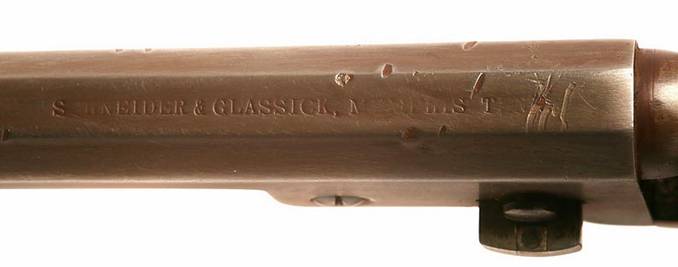 |
|
Fig.
30
Fake Schneider & Glassick Die Marking
(Compare
these markings to the High Standard Replica)
|
One week after this the fake Schneider & Glassick that I acquired
appeared on the Kull auction. There
were five fake revolvers being auctioned.
They included the Schneider & Glassick, a Griswold &
Gunnison, a Rigdon & Ansley with 12 Cylinder Stops, a Columbus
Firearms Co., a Vance & Feeney, and a .44cal. Dance Brother’s
revolver. I won the
Schneider & Glassick and the Rigdon & Ansley.
Interestingly, the Dance revolver brought $1,000 as a fake.
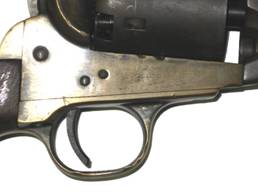 |
 |
| Fig.
31
Fake Schneider & Glassick Frame
Markings Removed
|
Fig.
32
Fake Schneider & Glassick Barrel
Marking Alteration & New
Serial Number
|
When I received the Schneider & Glassick it turned out to be a clone
of the one that I had examined at the
J.
M.
Davis
Gun
Museum
two weeks prior. Jason and I
made a close examination side by side comparison.
Everything was almost identical.
The serial numbers were #2 on mine and #4 on the museum example.
The two original brass Schneider & Glassick revolvers bear
the serial #6 & #23. The
third original Schneider & Glassick with the steel frame is #12M.
It appears that both of these Fake Schneider & Glassick
revolvers may have been done by the same person.
If a little more care had been taken by the counterfeiter they
could have passed as originals and would require more drastic tests of
materials and parts to authenticate them.
Without original specimens of the original revolvers and lack of
historical documentation it becomes very difficult to authenticate
originality. In the case of
these Schneider & Glassick revolvers a well informed replica
historian becomes a possible source for making an evaluation.
The Confederate made revolvers have become a prime target for
counterfeiting because of this, and because the collector interest is
increasing rapidly causing prices to appreciate dramatically.
Bibliography
Edwards, William B. Civil
War Guns.
Harrisburg
,
PA
: The Stackpole Company.
1962
Edwards, William B. “Unpublished
research Notes for Civil War Guns and other publications”
Afton
,
VA
Albaugh, William A.
III
and Simmons, Edward N. Confederate
Arms.
Harrisburg
,
PA
: The Stackpole Company. 1957
Albaugh, William A.
III
, Benet, Hugh and Simmons,
Edward N. Confederate
Handguns.
Philadelphia
,
PA
: Riling and Lentz.
1963
Gary, William A. Confederate
Revolvers.
Prescott
,
AZ
: K8 Communications.
1987
Flayderman, Norm. Flayderman’
Guide to Antique American Firearms and Their Values.
Northfield
,
ILL
: DBI Books.
1998
Fjestad, S. P., Blue
Book of Gun Values 8th
Edition.
Minneapolis
,
MN
: Investment Rarities. 1987
Replica Percussion Revolver Collector’s Association. “Confederate
Models” https://rprca.tripod.com/ModelsConfederate.html